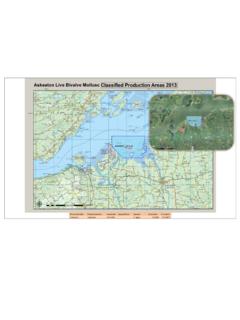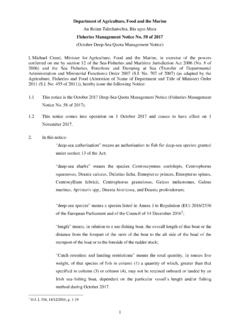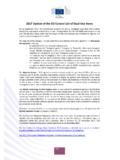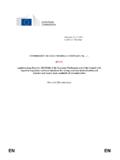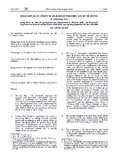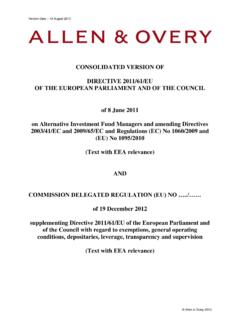Transcription of L 336/42 EN Official Jour nal of the European Union
1 commission delegated REGULATION (EU) 2015/2440 of 22 October 2015 establishing a discard plan for certain demersal fisheries in the North Sea and in Union waters of ICES Division IIa THE European commission , Having regard to the Treaty on the Functioning of the European Union , Having regard to Regulation (EU) No 1380/2013 of the European Parliament and of the Council of 11 December 2013 on the Common Fisheries Policy, amending Council Regulations (EC) No 1954/2003 and (EC) No 1224/2009 and repealing Council Regulations (EC) No 2371/2002 and (EC) No 639/2004 and Council Decision 2004/585/EC (1), and in particular Article 15(6) and Article 18(1) and (3) thereof, and to Council Regulation (EC) No 850/98 of 30 March 1998 for the conservation of fishery resources through technical measures for the protection of juveniles of marine organisms (2), and in particular Articles 18a and 48a thereof, Whereas: (1) Regulation (EU) No 1380/2013 aims to progressively eliminate discards in all Union fisheries through the introduction of a landing obligation for catches of species subject to catch limits.
2 (2) Article 15(6) of Regulation (EU) No 1380/2013 empowers the commission to adopt discard plans by means of delegated acts for a period of no more than three years on the basis of joint recommendations developed by Member States in consultation with the relevant Advisory Councils. (3) Belgium, Denmark, Germany, France, the Netherlands, Sweden and the United Kingdom have a direct fisheries management interest in the North Sea. Those Member States have submitted a joint recommendation to the commission after having consulted the North Sea Advisory Council and the Long Distance Advisory Council. Scientific contribution was obtained from relevant scientific bodies and reviewed by the Scientific, Technical and Economic Committee for Fisheries (STECF). The measures included in the joint recommendation comply with Article 18(3) of Regulation (EU) No 1380/2013. (4) For the purposes of Regulation (EU) No 1380/2013, the North Sea comprises ICES zones IIIa and IV.
3 As some demersal stocks relevant to the proposed discard plan are also to be found in Union waters of ICES Division IIa, Member States recommend that this Division is covered by the discard plan. (5) As regards the North Sea, in accordance with Article 15(1)(c) of Regulation (EU) No 1380/2013 the landing obligation applies to the species that define the fisheries which are subject to catch limits at the latest from 1 January 2016 in the mixed fisheries for cod, haddock, whiting and saithe; in the fisheries for Norway lobster; in the mixed fishery for common sole and plaice; in the fisheries for hake and in the fisheries for Northern prawn. In accordance with Article 15(5) of Regulation (EU) No 1380/2013, the discard plan identifies the species which have to be landed as from 1 January 2016. These species are saithe, haddock, Norway lobster, common sole, plaice, hake and Northern prawn.
4 This discard plan also establishes an obligation to land bycatches of Northern prawn. (6) The joint recommendation suggested that two exemptions from the landing obligation be applied to Norway lobster caught, respectively, with pots and with certain bottom trawls (OTB, TBN (3)) in ICES Division IIIa. Based on the scientific evidence provided in the joint recommendation and reviewed by STECF and taking into account L 336/42 Official Journal of the European Union EN (1) OJ L 354, , p. 22. (2) OJ L 125, , p. 1. (3) Gear codes used in this Regulation refer to those codes in Annex XI to commission Implementing Regulation (EU) No 404/2011 laying down detailed rules for the implementation of Council Regulation (EC) No 1224/2009 establishing a Community control system for ensuring compliance with the rules of the Common fisheries policy. For the vessels whose LOA is less than 10 metres gear codes used in this table refer to the codes from the FAO gear classification.
5 The characteristics of the gear, of the fishing practices and of the ecosystem, the commission considers that those exemptions should be included in this Regulation. Member States should submit additional data in order to enable STECF to further assess the survival rates of Norway lobster caught with the trawls concerned and the commission to review the relevant exemption after 2016. (7) The joint recommendation includes five de minimis exemptions from the landing obligation for certain fisheries and up to certain levels. The evidence provided by the Member States was reviewed by the STECF, which in general concluded that the joint recommendation, supported in some cases with a qualitative assessment of the costs, contained reasoned arguments that further improvements in selectivity are difficult to achieve and/or imply disproportionate costs in handling unwanted catches. As such conclusion is not contradicted by differing scientific information, it is appropriate to establish the de minimis exemptions in accordance with the percentage level proposed in the joint recommendation, within the limits of Article 15(5)(c) of Regulation (EU) No 1380/2013.
6 (8) The de minimis exemption suggested in the joint recommendation for common sole and haddock combined, up to a maximum of 2 % of the total annual catches of Norway lobster, sole and haddock in the fishery for Norway lobster by vessels using bottom trawls with a species selective grid in ICES Division IIIa, is based on the fact that increases in selectivity are very difficult to achieve. The STECF concluded that the supporting information is sufficient to justify the exemption claimed. Therefore, the exemption concerned should be included in this Regulation. (9) The de minimis exemption suggested in the joint recommendation for common sole, up to a maximum of 3 % of the total annual catches of this species by vessels using trammel and gill nets to catch common sole in ICES Division IIIa, Subarea IV and Union waters of ICES Division IIa, is based on the fact that increases in selectivity are very difficult to STECF concluded that the supporting information is sufficient to justify the exemption claimed.
7 Therefore, the exemption concerned should be included in this Regulation. (10) The de minimis exemption suggested in the joint recommendation for common sole smaller than 19 cm, up to a maximum of 3,7 % of the total annual catches of this species by vessels using beam trawl with a mesh size of 80-90 mm in ICES Subarea IV South of 55/56 N, is based on the fact that increases in selectivity are very difficult to achieve and that there is supporting quantitative information on disproportionate costs of handling of unwanted catches. The commission considers that it is appropriate to include that exemption in this Regulation. Member States should submit additional data as regards the costs concerned, in order to enable the commission to review that exemption after 2016. (11) The de minimis exemption suggested in the joint recommendation for common sole, up to a maximum of 7 % of the total annual catches of this species by vessels using beam trawls with increased selectivity in ICES Subarea IV, is based on the fact that increases in selectivity are very difficult to achieve.
8 The STECF concluded that the supporting information is sufficient to justify the suggested exemption. Therefore, the exemption concerned should be included in this Regulation. (12) The de minimis exemption suggested in the joint recommendation for Norway lobster smaller than minimum conservation reference size, up to a maximum of 6 % of the total annual catches of this species by vessels using certain bottom trawls in ICES Subarea IV and Union waters of ICES Division IIa, is based on the fact there is supporting quantitative information on disproportionate costs of handling and disposal of unwanted catches. The STECF concluded that the supporting information is sufficient to justify the suggested exemption. Therefore, the exemption concerned should be included in this Regulation. (13) Article 18a of Regulation (EC) No 850/98 empowers the commission to establish, for the purpose of adopting discard plans and for the species subject to the landing obligation, a minimum conservation reference size (MCRS) with the aim of ensuring the protection of juveniles of marine organisms.
9 MCRS may derogate, where appropriate, from the sizes established in Annex XII to that Regulation. Currently, for Norway lobster a MCRS of 130 mm is established in that Annex XII. Scientific evidence reviewed by the STECF supports the setting of MCRS for Norway lobster at 105 mm. In particular, STECF concluded that the proposed MCRS is above the average maturity size and that the risk to the population of reducing the MCRS in ICES Division IIIa is small. L 336/43 Official Journal of the European Union EN (14) Discard plans may also include technical measures regarding fisheries or species covered by the landing obligation. In order to increase gear selectivity and reduce unwanted catches in the Skagerrak, it is appropriate to provide for a number of technical measures, which were agreed between the Union and Norway in 2011, (1) and 2012 (2). (15) In order to ensure appropriate control, specific requirements for the Member States to establish lists of vessels covered by this Regulation should be laid down.
10 (16) As the measures provided for in this Regulation have a direct impact on the economic activities linked to and the planning of the fishing season of Union vessels, it should enter into force immediately after its publication. It should apply from 1 January 2016 in order to comply with the time-frame set out in Article 15 of Regulation (EU) No 1380/2013. In accordance with Article 15(6) of that Regulation, this Regulation should apply for no more than one year, HAS ADOPTED THIS REGULATION: Article 1 Scope This Regulation specifies the details for implementing the landing obligation, provided for in Article 15(1) of Regulation (EU) No 1380/2013, in the North Sea and in Union waters of ICES Division IIa that shall apply in the fisheries set out in the Annex to this Regulation. Article 2 Survivability exemption 1. The exemption from the landing obligation provided for in Article 15(4)(b) of Regulation (EU) No 1380/2013, for species for which scientific evidence demonstrates high survival rates, shall apply to the following catches of Norway lobster: (a) catches with pots (FPO); (b) catches in ICES Division IIIa with bottom trawls (OTB, TBN) with a mesh size of at least 70 mm equipped with a species selective grid with bar spacing of maximum 35 mm; and (c) catches in ICES Division IIIa with bottom trawls (OTB, TBN) with a mesh size of at least 90 mm equipped with a top panel of at least 270 mm mesh size (diamond mesh) or at least 140 mm mesh size (square mesh).


